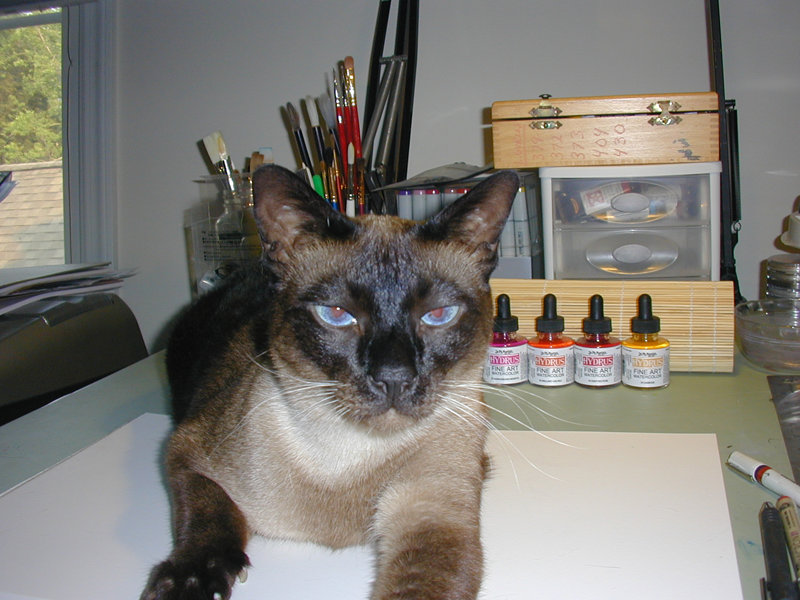Making Your Own Illuminations Part 2 – Superman Comics, Medieval Illuminations and Miniatures
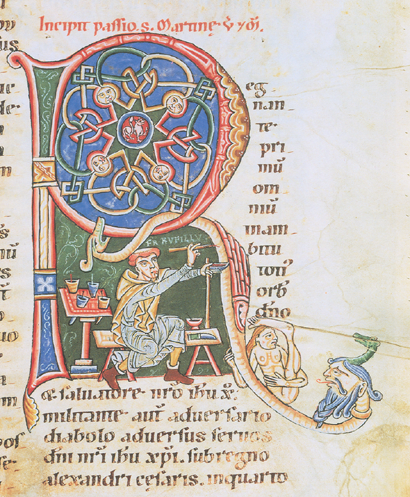
Frater Rufillus of Weissenau self-portrait in decorated initial from Medieval Illuminators and Their Methods of Work
Did I get your attention with the title of this lesson? I hope so. Besides medieval history, one of my interests is comic book art. Until recently, when digital methods superseded hand-drawn art, comic books were made in the same way that medieval artists created their magnificent illuminated books. There are three parts to creating the figure art in a comic book. The penciller draws the comic in the familiar framed format of the comic book, the inker inks over the lines drawn by the penciller and the colorist colors the image to produce final art. One person or many people may be involved in this process. This is exactly how medieval artists created their books and it is how we will create our illuminated writing.
This will require a few simple tools. The first, of course, is paper. My personal preference is 500 series Strathmore Bristol plate surface. Your choice should be made based upon your materials. I use watercolor, ink, some acrylics and colored pencils for my writing. They all work well on this surface. Since this is all for fun and for learning and for making mistakes, feel free to use whatever you have on hand. If you decide to continue beyond these simple tutorials, then you can purchase more expensive supplies at that time.
Many folks feel great anxiety when faced with drawing anything. If this is you, you might want to consider purchasing transfer paper. If you’re scared, intimidated and freaked, relax. You can choose images you want to replicate and transfer them to your drawing surface using carbon paper. Something like was done in medieval times and you can do it, too. You can even do it on the cheap. Take a piece of cheap printer/copier paper and cover one side with lead from a 2B pencil. This is a little messy but it will allow you to carbon transfer your image.
Planning the writing, requires ruling the page. A ruler will suffice. A ruler and a triangle are better. In addition to the basic tools, I have a series of french curves and ellipsoid templates. These are very useful and speed the process.
Finally, we come to the actual tools used to put design and color on the page. You will need a pencil, not too hard and not too soft. You will need something to make a permanent fine black line such as a Pigma Micron or Copic multiliner/marker. I use a fountain pen and/or a dip pen with Noodler’s Ink for my writing. You don’t need to get fancy and a simple finepoint black Sharpie marker will do. Use what you have and keep it cheap.
I’ve left color and illuminating gold for last. How you do this depends on what effect you want to achieve. Is this just a fun exercise and you’re doing it all on the cheap? Fine, use some watercolor and/or colored pencil. Are you trying for the look of an old book or do you want your writing to have the look of a brand new manuscript? What we see today are faded versions of the original writing. The colors were brilliant and intense when the original pages were created but the palette was limited. Look at the decorated letter at the start of this tutorial. Notice the little bowls of color the artist is using. You will need only a basic color set in whatever media you choose.
Derwent Inktense Watercolor Pencils
Do you want it all in a simple package? Derwent Inktense Pencils are fantastic tools for creating bright, bold colors and outlining with “ink”. The smallest set will provide all of the colors you need. The very nice part about these pencils is that they come with a black (ink) outlining pencil that is waterproof. It’s all there except for the illuminating gold. I use these pencils all the time and you can get many different effects with them.
Dr. Ph. Martin’s Hydrus Fine Art Watercolor Sets
I use Dr. Ph. Martin’s Hydrus Watercolor to color my writing when I want striking brilliant color.
Illuminating Gold
I use a gold paint from Golden Acrylics called “Iridescent Gold Deep (Fine)” for illuminating my writing. To start, I suggest you use one of the many available metallic gel markers. They’re cheap and easy to find.
That covers everything you will need to get started. In the next lesson, we’ll start looking at putting design on the page. Have fun with this. You might find a hobby that will last a lifetime. Finally, invite a friend to try it with you. It’s more fun that way. Here’s my friend. He’s always eager to give me a helping hand….
May 22, 2011 2 Comments
The Vatican Library – The Pope’s Library
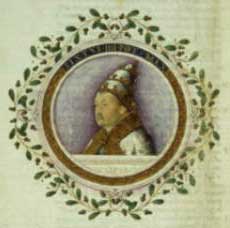 Since the Pope is visiting, I thought I’d call attention to the Vatican Library Exhibit on the Library of Congress web site. It’s a very informative short history of Rome and the library with a gallery of book manuscripts including many that are illuminated. The history of the Vatican Library is a fascinating story and what book lover hasn’t imagined roaming those stacks and finding a long lost book? From the Library of Congress page:
Since the Pope is visiting, I thought I’d call attention to the Vatican Library Exhibit on the Library of Congress web site. It’s a very informative short history of Rome and the library with a gallery of book manuscripts including many that are illuminated. The history of the Vatican Library is a fascinating story and what book lover hasn’t imagined roaming those stacks and finding a long lost book? From the Library of Congress page:
The Vatican Library, in fact, became a center of the revival of classical culture known as the Renaissance. Its librarians were often distinguished scholars. Historians and philosophers, clerics and magicians visited the collections and borrowed books from them. By 1581, when the French writer Michel de Montaigne visited Rome, the treasures of the Vatican had become a mandatory stop on any well-informed traveller’s Roman itinerary. To his delight, Montaigne was shown ancient Roman and ancient Chinese manuscripts, the love letters of Henry VIII, and the classics of history and philosophy (many of which can be seen in this exhibition). Then, as now, the Vatican Library was one of the greatest in the Western world.
April 16, 2008 Comments Off on The Vatican Library – The Pope’s Library
“A Tale of Two Manuscripts Reunited” – 14th Century Medieval Love Poem
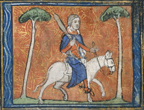 Two 14th Century love poems have been reunited at the University of Chicago. From their press release:
Two 14th Century love poems have been reunited at the University of Chicago. From their press release:
The University of Chicago Library acquired a 14th-century manuscript of “Le Roman de la Rose,” or “The Romance of the Rose” – which scholars have referred to as the most popular medieval love poem – reuniting it after a 100-year separation with a manuscript with which it was previously bound.
In 1907, the manuscript of “Le Roman de la Rose” was separated from that of “Le Jeu des Echecs Moralise,” or “The Moralized Game of Chess,” which the University of Chicago Library acquired in 1931.
Both manuscripts will be on display in the Library’s Special Collections Research Center at 1100 E. 57th St., beginning Feb. 14 as part of the exhibition: “Romance and Chess: A Tale of Two Manuscripts Reunited.” Opening remarks will be made at 12:30 p.m. at the Valentine’s Day opening by Alice Schreyer, Director of the Special Collections Research Center; Daisy Delogu, Assistant Professor of Romance Languages and Literature; and Aden Kumler, Assistant Professor of Medieval Art and Architecture at the University of Chicago. The event is free and open to the public. The exhibit will run through March 14.
“Bringing the two parts of this book back together will enable discoveries that would not be possible if they remained apart,” Schreyer said.
Added Delogu, “This ‘Le Roman de la Rose’ manuscript has extraordinary potential to enrich research and teaching opportunities here at Chicago, and will be of interest to scholars of manuscript culture and literary studies worldwide. ‘Le Roman de la Rose’ is arguably the single-most influential vernacular text of the late French Middle Ages.”
These beautiful manuscripts are currently on display at the University of Chicago. You can learn more about the history of these 14th century poems at the University of Chicago Library web site.
March 4, 2008 Comments Off on “A Tale of Two Manuscripts Reunited” – 14th Century Medieval Love Poem
England’s Medieval Books of Hours – A New Book from Eamon Duffy
 Of all the beautiful manuscripts from the Middle Ages that have survived, none is more common than Books of Hours. In fact, it has been said that “Books of Hours are now more widely scattered around the world than any other object made in the Middle Ages” ( from: “A History of Illuminated Manuscripts
Of all the beautiful manuscripts from the Middle Ages that have survived, none is more common than Books of Hours. In fact, it has been said that “Books of Hours are now more widely scattered around the world than any other object made in the Middle Ages” ( from: “A History of Illuminated Manuscripts“). Books of hours provided a framework for lay people to practice monastic devotional routines. After the upheaval of the Black Death in the 14th century, the popularity of the form surged and, by the later Middle Ages, these books were mass produced. One of the most famous and finely painted Book of Hours is the Très Riches Heures. My favorite illustration, however, is from the Hours of Catherine of Cleves, Duchess of Guelders (1417-1476). Shown below, this miniature shows an angel leading figures out of the mouth of Hell.
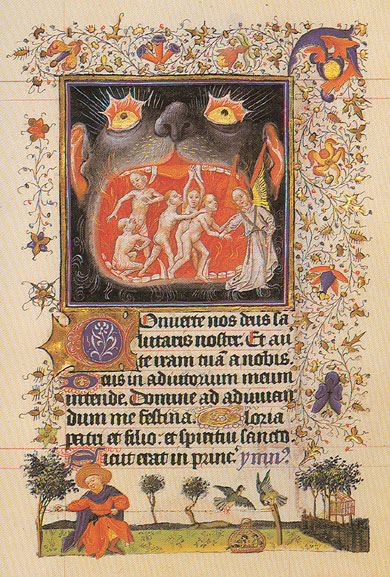
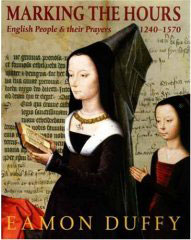 If you’re a fan of this type of illustration and calligraphy as I am, you’ll want to get your hands on a copy of a new book published on the Books of Hours by the religious historian Eamon Duffy. “Marking the Hours: English People and Their Prayers, 1240-1570
If you’re a fan of this type of illustration and calligraphy as I am, you’ll want to get your hands on a copy of a new book published on the Books of Hours by the religious historian Eamon Duffy. “Marking the Hours: English People and Their Prayers, 1240-1570” was reviewed in The Guardian recently. Duffy’s new book emphasizes the individual owners of these books. He’s most interested in the personal comments as well as the inclusion of commissioned images of the owners themselves in the beautiful miniatures. These additions are rare glimpses into the individual minds of people from the Middle Ages. From that review:
In the Middle Ages if you were female, comfortably-off and hoped to go to heaven then you almost certainly possessed a Book of Hours. Tucked up your sleeve or kept close by in a special place, the Book was your spiritual guide to the ordinary day. It didn’t speak intimately, nor was it interested in your particular circumstances. Instead it marked the passing of the liturgical “hours” – Matins, Prime, Vespers – giving you a set of prayers and psalms to raise your spirits as you negotiated a schedule more immediately concerned with sulky servants and sickly children than the glories of the Risen Christ.
The review in The Guardian continues:
The kinds of scrawls that people added to their Book of Hours included the names of favourite saints – Apollonia was good for toothache, while Zita was helpful with lost keys. If you were sufficiently rich and important you could get the artist to include a specially commissioned picture of yourself at the front of the book perhaps even – tricksy this – showing yourself reading the very Book of Hours in which you now metaphorically resided. There was even the option of getting yourself inserted into standard biblical scenes. One woman had herself painted as a spectator at the Annunciation, muscling in on Mary and Gabriel’s special moment. Others, more tactfully, waited until the Virgin was actually in heaven and had themselves painted floating on a nearby cloud.
I find this type of history fascinating and I’ve already pre-ordered my copy of Duffy’s book.
[tags]book of hours, eamon duffy, illuminated manuscript, calligraphy, medieval history, middle ages[/tags]
December 30, 2006 Comments Off on England’s Medieval Books of Hours – A New Book from Eamon Duffy
Joan of Arc at the Corcoran Gallery of Art in Washington, DC
 From November 18, 2006 through January 21, 2007, the Corcoran Gallery of Art in Washington, D.C. is presenting an exhibition on Joan of Arc (ce 1412-1431). There aren’t many historical figures with a more interesting resume than Joan of Arc. What’s more fun than a cross-dressing religious fanatic warrior who is burned at the stake and later made a saint. It’s good stuff and it has been an artistic inspiration for many over the centuries. From the gallery web site:
From November 18, 2006 through January 21, 2007, the Corcoran Gallery of Art in Washington, D.C. is presenting an exhibition on Joan of Arc (ce 1412-1431). There aren’t many historical figures with a more interesting resume than Joan of Arc. What’s more fun than a cross-dressing religious fanatic warrior who is burned at the stake and later made a saint. It’s good stuff and it has been an artistic inspiration for many over the centuries. From the gallery web site:
The exhibition surveys more than 200 French and American works produced over five centuries, including paintings, sculpture, illustrated books and manuscripts, textiles and popular art on loan from major institutions, including the Metropolitan Museum of Art, the National Gallery of Art, the John and Mable Ringling Museum, the Library of Congress, Harvard University, the Boston Public Library and Columbia University. These varied loans contextualize Boutet de Monvel’s Joan of Arc works in the Corcoran’s collection.
This represents a unique opportunity in the Washington, D.C. area to see illuminated manuscripts from a variety of institutions. In addition, it’s interesting to see the form that the Joan of Arc story has taken over the centuries.
[tags]illuminated manuscript, Corcoran Gallery of Art, Joan of Arc, medieval history, 15th century[/tags]
November 24, 2006 Comments Off on Joan of Arc at the Corcoran Gallery of Art in Washington, DC

